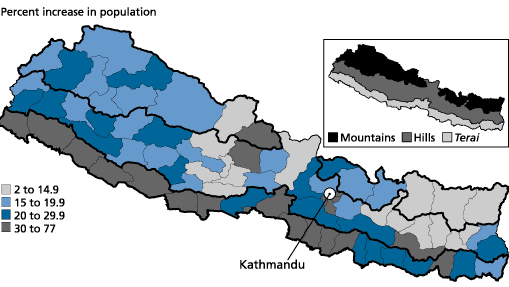
Population Growth Continues to Hinder Nepal’s Economic Progress
Date
July 26, 2002
Author
(July 2002) Wedged between the world’s two population billionaires, China and India, Nepal is struggling with its own population pressures. The country’s 23 million people, most of whom make their living from farming, have nearly run out of land to cultivate, while their numbers continue to grow; poverty, the highest outside of Africa, persists; and internal conflict is draining already scarce resources.
Nepal’s 10th population census, conducted in June 2001, produced a population count of 23,214,681. That number marked an increase of 5 million since the previous census in 1991 and an average annual growth rate of 2.3 percent. According to the census, 86 percent of this growing population lives in rural areas, and 82 percent of the economically active population works in agriculture, fishing, or forestry.
Because one-third of the country consists of mountains or hills, little additional land is available to tend. The share of land being cultivated rose from 17 percent in 1974 to 30 percent in 1998, and the remaining areas that could be added consist mostly of slopes and marginal lands that are environmentally sensitive and less productive.
Population Growth in Nepal by District, 1991-2001

Source: Central Bureau of Statistics, Nepal.
Population Growth in Nepal by Region, 1991-2001
| % Increase | |||
|---|---|---|---|
| Region | 1991 | 2001 | 1991-2001 |
| Mountain | 1,443,130 | 1,690,263 | 17.1 |
| Hill | 8,417,889 | 10,271,506 | 22 |
| Terai | 8,628,078 | 11,252,912 | 30.4 |
Source: Central Bureau of Statistics, Nepal.
With population growth exceeding growth in agricultural production for the past three decades, poverty has become a fixture. Nepal is the poorest country in the world outside of Africa: With an annual gross national income per capita in 1999 of US$220, it ranked 164th out of 173 countries for which data were available. Even when income figures are adjusted to reflect the local cost of living, Nepal rises to only 134th out of 158 countries, higher only than neighboring Bhutan and the poorest African countries. The poverty rate in the country has remained at the same level for as long as it has been measured. According to the first Multi-Purpose Household Budget Survey in 1984-1985, 42 percent of the population was poor, and the most recent Nepal Living Standards Survey, conducted in 1995-1996, matched that percentage, although the methodologies may not be strictly comparable.
To combat poverty, the country has implemented a series of five-year economic development plans, the ninth of which ends this year. The current plan has made population management a central development goal, setting objectives of moving toward a two-child family norm and bringing fertility to replacement level — the level at which a couple has only enough children to replace themselves, or about two children per couple — within 20 years. The 2001 Demographic and Health Survey showed that the current total fertility rate or average number of children per woman is 4.1. In March, Nepal’s parliament legalized abortion to reduce maternal mortality. The maternal mortality ratio, 830 per 100,000 live births, is the fourth highest in the world outside of Africa.
Beyond promoting smaller families, the government has been redistributing poor, landless people to less densely populated areas of the terai, or plains (the lowest of the three topographical bands shown in the accompanying map). The terai contain the majority of the country’s arable land.
Since the advent of malaria-control measures in the 1950s, the terai have been the major region of population growth due to migration from the hill and mountain regions (see table). Outside of the terai, the fastest growing region in the country has been the capital city of Kathmandu, whose population exceeded 1 million people for the first time in the 2001 census. Yet government efforts to address population and to promote overall economic development have come under threat. Since 1996, Maoist rebels have been trying to overthrow Nepal’s multiparty democracy and constitutional monarchy to establish a totalitarian communist republic. They have attempted to exploit the young and the poor in remote rural regions, and the violent clashes between them and the government have severely crippled the tourism industry, one of Nepal’s major sources of foreign currency.
With a young population — 42 percent of people were under age 15 in 1991 — the country will continue to grow rapidly. Even if past fertility declines continue, the Ministry of Population and Environment still projects that the population will reach 32 million by 2016. In light of that increase, the prospects for economic growth and political stability appear fragile.
Timothy Heleniak is a research fellow at the Woodrow Wilson International Center for Scholars and an adjunct professor of demography and geography at Georgetown University.









